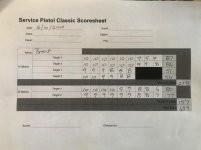Have any of you gotten the sense that the NRA is turning away from Precision (i.e.: Bullseye) Pistol?
Their magazine "Shooting Sports USA" has nearly dropped it in favor of action games. And, as far as match organization is concerned, have they really come to terms with their rivalry with the CMP?
I get it that the polymer, hi-cap gun-makers are a big advertiser faction for American Rifleman, etc. and they need a "gun game" in which those guns can be competitive.
To express my concerns, i just wrote the following letter to NRA:
"I am grateful to receive your Shooting Sports USA magazine. But, I am dismayed by the total shift of pistol shooting coverage towards the action games. Honestly, you've lost me as a competitive shooter.
I think it is a big mistake to lock Precision Pistol into the obsolete 2700 framework. It is killing the sport. For the "45 stage", NRA has lost sight that 1) the 1911 is no longer the US service pistol, and hasn't been for some decades, and 2) even if it was, the current rules are out of touch with the spirit of the "service pistol" intent of the third stage of the 2700. Red dot sights, light triggers, even adjustable target sights, are contrary to the spirit of the game. The 45 stage, as is, should be dropped or radically changed to get back to the idea of a service pistol match.
Precision pistol is a tough game, and should remain as such.
Perhaps a good "fun" match would be a "Vintage Service Pistol" Precision match, with a cutoff of, say, V-E day for what would be allowed. This has been a successful approach to rifle."
I would like to emphasize that I am a Life Member, and fully support the organization. But, they're not supporting pistol near to what they do for rifle.
I'll let y'all know if I get a reply....
Jim
Their magazine "Shooting Sports USA" has nearly dropped it in favor of action games. And, as far as match organization is concerned, have they really come to terms with their rivalry with the CMP?
I get it that the polymer, hi-cap gun-makers are a big advertiser faction for American Rifleman, etc. and they need a "gun game" in which those guns can be competitive.
To express my concerns, i just wrote the following letter to NRA:
"I am grateful to receive your Shooting Sports USA magazine. But, I am dismayed by the total shift of pistol shooting coverage towards the action games. Honestly, you've lost me as a competitive shooter.
I think it is a big mistake to lock Precision Pistol into the obsolete 2700 framework. It is killing the sport. For the "45 stage", NRA has lost sight that 1) the 1911 is no longer the US service pistol, and hasn't been for some decades, and 2) even if it was, the current rules are out of touch with the spirit of the "service pistol" intent of the third stage of the 2700. Red dot sights, light triggers, even adjustable target sights, are contrary to the spirit of the game. The 45 stage, as is, should be dropped or radically changed to get back to the idea of a service pistol match.
Precision pistol is a tough game, and should remain as such.
Perhaps a good "fun" match would be a "Vintage Service Pistol" Precision match, with a cutoff of, say, V-E day for what would be allowed. This has been a successful approach to rifle."
I would like to emphasize that I am a Life Member, and fully support the organization. But, they're not supporting pistol near to what they do for rifle.
I'll let y'all know if I get a reply....
Jim

